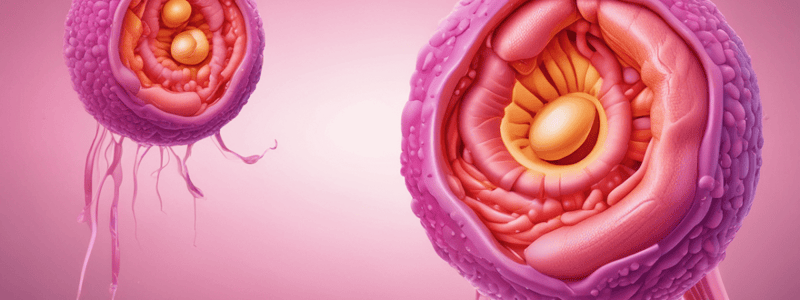Podcast
Questions and Answers
What is the most common cause of sexually transmitted epididymitis in men under 35?
What is the most common cause of sexually transmitted epididymitis in men under 35?
- Chlamydia trachomatis (correct)
- E. coli
- Neisseria meningitidis
- Staphylococcus aureus
Which group of men is more likely to experience non-sexually transmitted epididymitis?
Which group of men is more likely to experience non-sexually transmitted epididymitis?
- Men under 30
- Men between 35-50
- Men above 35 (correct)
- Men between 30-35
What is a possible route of infection leading to epididymitis?
What is a possible route of infection leading to epididymitis?
- Urethra to ejaculatory duct to vas deferens to epididymis (correct)
- Via the bloodstream
- From the bladder to the scrotum
- From the testicles to the urethra
Which medication has been associated with self-limited epididymitis in a dose-dependent manner?
Which medication has been associated with self-limited epididymitis in a dose-dependent manner?
What clinical manifestation is commonly associated with epididymitis?
What clinical manifestation is commonly associated with epididymitis?
Which sign, although suggestive, is not entirely reliable in diagnosing epididymitis?
Which sign, although suggestive, is not entirely reliable in diagnosing epididymitis?
How does epididymitis commonly present in patients?
How does epididymitis commonly present in patients?
What is a common etiology associated with orchitis?
What is a common etiology associated with orchitis?
Which diagnostic modality can be used to differentiate orchitis from torsion or abscess?
Which diagnostic modality can be used to differentiate orchitis from torsion or abscess?
What is a common presentation of orchitis in terms of testicular involvement?
What is a common presentation of orchitis in terms of testicular involvement?
What is the underlying cause of a hydrocele?
What is the underlying cause of a hydrocele?
Which condition may be secondary to a hydrocele?
Which condition may be secondary to a hydrocele?
What is a common presenting symptom of hydroceles?
What is a common presenting symptom of hydroceles?
What is the typical presentation of varicocele?
What is the typical presentation of varicocele?
Which side of the body is a varicocele more commonly found on?
Which side of the body is a varicocele more commonly found on?
What risk factor can contribute to the development of a varicocele?
What risk factor can contribute to the development of a varicocele?
What is a common diagnostic finding associated with testicular torsion?
What is a common diagnostic finding associated with testicular torsion?
What characterizes the typical presentation of testicular cancer?
What characterizes the typical presentation of testicular cancer?
What is the most common type of primary testicular tumor?
What is the most common type of primary testicular tumor?
The diagnosis of a hydrocele is readily made by transillumination.
The diagnosis of a hydrocele is readily made by transillumination.
Engorgement of the internal spermatic veins above the testis is called
Engorgement of the internal spermatic veins above the testis is called
Testicular torsion is also called a bell clapper deformity
Testicular torsion is also called a bell clapper deformity
Patient with _______ will presents with the complaint of acute onset, severe lower abdominal, inguinal or testicular pain
Patient with _______ will presents with the complaint of acute onset, severe lower abdominal, inguinal or testicular pain
Patients with suspected testicular torsion need to be evaluated by a urologist within 4-6 hours as this is a medical emergency
Patients with suspected testicular torsion need to be evaluated by a urologist within 4-6 hours as this is a medical emergency
Testicular cancer is staged using the TNM system created based on extent of cancer in the testis, status of regional lymph nodes, the presence of metastases in distant lymph nodes or other viscera, and serum levels of tumor markers
Testicular cancer is staged using the TNM system created based on extent of cancer in the testis, status of regional lymph nodes, the presence of metastases in distant lymph nodes or other viscera, and serum levels of tumor markers
Diagnosis of testicular cancer is always by
Diagnosis of testicular cancer is always by
Screening for testicular cancer by self-examination or clinician examination is unlikely to offer meaningful health benefits and could potentially cause harms include false-positive results, anxiety, and harms from diagnostic tests or procedures
Screening for testicular cancer by self-examination or clinician examination is unlikely to offer meaningful health benefits and could potentially cause harms include false-positive results, anxiety, and harms from diagnostic tests or procedures
Flashcards are hidden until you start studying




